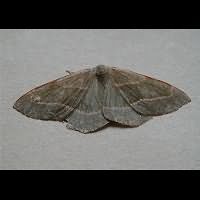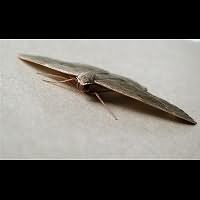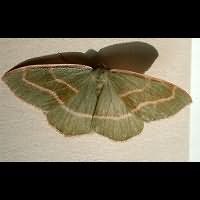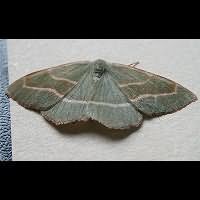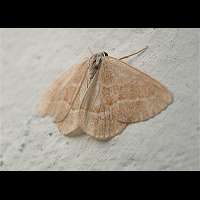Barred Red (Hylaea fasciaria)
In this case the name seems very unappropiated, for in most of the pictures the moth is green, while called Barred Red. That's because this species comes in two tastes: red and green and also produces many intermediate forms. In Britain the red form is predominant, while on the continent green animals are about as common as red ones. In our garden however we usually see green ones. The green forms however usually have a reddish tone to them, especially around and between the two lines. Generally in whatever colour the animal appears, it has no real doppelgangers. Contrary to many other green geometers, the green doesn't fade into white, yellow or brown. The size is that of a typical Geometer, because it has a wingspan of 32 to 44 mm.
The eggs hatch in September, but the larvae grow very slowly. Being quite small they enter hibernation, usually staying on the foodplant. In spring they compltete their development. They pupate in May on the ground between fallen needles. Pupation takes 4 to 6 weeks. The caterpillar itself is greyish or greyish brown with some brownish smears and a lightbrown head. On the back is a series of small warts. The larvae will reach a length of some 30 to 34 mm. They live on conifers exclusively, mainly Scots Pine and Norway Spruce, but others as well, including Douglas' Firs and Larch.
The Barred Red has two generations on the continent, but in Britain and Northern Europe usually there's only one, on the wing from mid-June to early August. Flies by night only, but can easily be disturbed at it's resting place during the day. Comes to light, sometimes even in great numbers. The Barred Red is a common species wherever there are conifers: woodland, parks and gardens, even in urban areas.
In this case the name seems very unappropiated, for in most of the pictures the moth is green, while called Barred Red. That's because this species comes in two tastes: red and green and also produces many intermediate forms. In Britain the red form is predominant, while on the continent green animals are about as common as red ones. In our garden however we usually see green ones. The green forms however usually have a reddish tone to them, especially around and between the two lines. Generally in whatever colour the animal appears, it has no real doppelgangers. Contrary to many other green geometers, the green doesn't fade into white, yellow or brown. The size is that of a typical Geometer, because it has a wingspan of 32 to 44 mm.
The eggs hatch in September, but the larvae grow very slowly. Being quite small they enter hibernation, usually staying on the foodplant. In spring they compltete their development. They pupate in May on the ground between fallen needles. Pupation takes 4 to 6 weeks. The caterpillar itself is greyish or greyish brown with some brownish smears and a lightbrown head. On the back is a series of small warts. The larvae will reach a length of some 30 to 34 mm. They live on conifers exclusively, mainly Scots Pine and Norway Spruce, but others as well, including Douglas' Firs and Larch.
The Barred Red has two generations on the continent, but in Britain and Northern Europe usually there's only one, on the wing from mid-June to early August. Flies by night only, but can easily be disturbed at it's resting place during the day. Comes to light, sometimes even in great numbers. The Barred Red is a common species wherever there are conifers: woodland, parks and gardens, even in urban areas.

